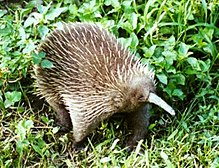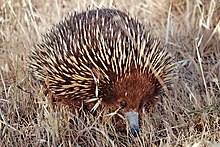Echidna: Difference between revisions
m Reverted 1 edit by 98.220.19.168 identified as vandalism to last revision by Animules. using TW |
mating rituals |
||
| Line 30: | Line 30: | ||
[[Image:French Island Echidna.ogg|right|thumb|A [[French Island National Park|French Island]] echidna building a defensive burrow (0:43s)]] |
[[Image:French Island Echidna.ogg|right|thumb|A [[French Island National Park|French Island]] echidna building a defensive burrow (0:43s)]] |
||
[[Image:Wild shortbeak echidna.jpg|thumb|right|Short-beaked Echidna]] |
[[Image:Wild shortbeak echidna.jpg|thumb|right|Short-beaked Echidna]] |
||
'''Echidnas''' ({{pronEng|ɨˈkɪdnə}}), also known as ''' |
'''Echidnas''' ({{pronEng|ɨˈkɪdnə}}), also known as '''Knuckles( from Sonic''',<ref>http://www.enchantedlearning.com/subjects/mammals/echidna/Echidnaprintout.shtml Retrieved on [[21 October]] [[2007]]</ref> are four [[Extant taxon|extant]] [[mammal]] species belonging to the '''Tachyglossidae''' [[Family (biology)|family]] of the [[monotreme]]s, an order of egg laying mammals. Together with the [[Platypus]], they are the only surviving members of that [[order (biology)|order]] comprising the only extant mammals that lay eggs. Although their diet consists largely of ants and termites, they are not actually related to the [[anteater]] species. They live in [[New Guinea]] and [[Australia]]. The echidnas are named after a [[Echidna (mythology)|monster in ancient Greek mythology]]. |
||
==Description== |
==Description== |
||
Revision as of 22:38, 27 April 2009
This article includes a list of references, related reading, or external links, but its sources remain unclear because it lacks inline citations. (May 2008) |
| Echidnas[1] Temporal range:
| |
|---|---|

| |
| Western Long-beaked Echidna | |
| Scientific classification | |
| Kingdom: | |
| Phylum: | |
| Class: | |
| Order: | |
| Family: | Tachyglossidae Gill, 1872
|
| Species | |
|
Genus Tachyglossus | |



Echidnas (Template:PronEng), also known as Knuckles( from Sonic,[2] are four extant mammal species belonging to the Tachyglossidae family of the monotremes, an order of egg laying mammals. Together with the Platypus, they are the only surviving members of that order comprising the only extant mammals that lay eggs. Although their diet consists largely of ants and termites, they are not actually related to the anteater species. They live in New Guinea and Australia. The echidnas are named after a monster in ancient Greek mythology.
Description
Echidnas are small mammals that are covered with coarse hair and spines. Superficially they resemble the anteaters of South America, and other spiny mammals like hedgehogs and porcupines. They have snouts which have the functions of both the mouth and nose. Their snouts are elongated and slender. They have very short, strong limbs with large claws and are powerful diggers. Echidnas have a tiny mouth and a toothless jaw. They feed by tearing open soft logs, anthills and the like, and use their long, sticky tongue which protrudes from their snout to collect their prey. The Short-beaked Echidna's diet consists largely of ants and termites, while the Zaglossus species typically eat worms and insect larvae.
The long-beaked echidnas have tiny spines on their tongues that help capture their meals.
Echidnas and the Platypus are the only egg-laying mammals, known as monotremes. The female lays a single soft-shelled, leathery egg twenty-two days after mating and deposits it directly into her pouch. Hatching takes ten days; the young echidna, called a puggle, then sucks milk from the pores of the two milk patches (monotremes have no nipples) and remains in the pouch for forty-five to fifty-five days, at which time it starts to develop spines. The mother digs a nursery burrow and deposits the puggle, returning every five days to suckle it until it is weaned at seven months.
Male echidnas have a four-headed penis, but only two of the heads are used during mating. The other two heads "shut down" and do not grow in size. The heads used are swapped each time the mammal copulates.[3]
Contrary to previous research, the Echidna does enter REM sleep, albeit only when the ambient temperature of its environment is around 25°C. At the temperatures of 15°C and 28°C, REMS is suppressed.[citation needed]
Taxonomy
Echidnas are classified into three genera. The Zaglossus genus includes three extant species and two species known only from fossils, while only one species from the genus Tachyglossus is known. The third genus, Megalibgwilia, is only known from fossils.
Zaglossus
The three living Zaglossus species are endemic to New Guinea. They are rare and are hunted for food. They forage in leaf litter on the forest floor, eating earthworms and insects. The species are:
- the Western Long-beaked Echidna (Zaglossus bruijni) of the highland forests
- Sir David's Long-beaked Echidna (Zaglossus attenboroughi), recently discovered, prefers a still higher habitat
- the Eastern Long-beaked Echidna (Zaglossus bartoni), of which four distinct subspecies have been identified
The two fossil species are:
Tachyglossus
The Short-beaked Echidna (Tachyglossus aculeatus) is found in southeast New Guinea and also occurs in almost all Australian environments, from the snow-clad Australian Alps to the deep deserts of the Outback, essentially anywhere that ants and termites are available. Its size is smaller than the Zaglossus species, and it has longer hair.
Megalibgwilia
The genus Megalibgwilia is only known from fossils:
- Megalibgwilia ramsayi from Late Pleistocene sites in Australia
- Megalibgwilia robusta from Miocene sites in Australia
References
- ^ Groves, C. P. (2005). Wilson, D. E.; Reeder, D. M. (eds.). Mammal Species of the World: A Taxonomic and Geographic Reference (3rd ed.). Baltimore: Johns Hopkins University Press. pp. p. 1-2. ISBN 0-801-88221-4. OCLC 62265494.
{{cite book}}:|pages=has extra text (help) - ^ http://www.enchantedlearning.com/subjects/mammals/echidna/Echidnaprintout.shtml Retrieved on 21 October 2007
- ^ Shultz, N. (2007-10-26). "Exhibitionist spiny anteater reveals bizarre penis". New Scientist website. Retrieved 2006-10-27.
{{cite web}}: Check date values in:|date=(help); External link in|work=
- Flannery, T.F. and Groves, C.P. (1998) A revision of the genus Zaglossus (Monotremata, Tachyglossidae), with description of new species and subspecies. Mammalia 62, 367-396.
- Parker, J., "Echidna Love Trains", "Scribbly Gum" online magazine.
- Rismiller, P., "Echidnas and Goannas of Kangaroo Island", Earthwatch Institute.
External links
- "The Enigma of the Echidna" by Doug Stewart, National Wildlife, April/May 2003.
- Scribbly Gum - Australian Broadcasting Corporation online magazine, article "Echidna Love Trains": Echidna spotting, Trains (breeding behaviour), The amazing puggle (young), Species, Dreaming (REM sleep), Managing populations; June 2000
